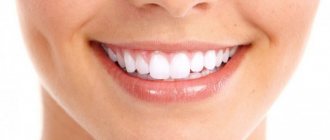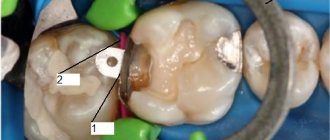Increased tooth wear – This is a process of increased tissue loss: first, the enamel becomes thinner, and then the inside of the teeth. Typically, the process of abrasion is constant - teeth gradually wear out throughout human life: first, the tooth enamel becomes thinner, and in old age it comes to the inner layers. Increased abrasion is a similar process that occurs at an accelerated rate: a real problem, and we will tell you how to deal with it.
The pathological loss of dentin and enamel is different in that it occurs much faster than with normal physiological abrasion. In this case, we talk about abnormal tooth wear, which is a recognized dental problem that mainly affects men over the age of 30. In this case, the decrease in the dental layer begins gradually, and as it progresses, it is no longer possible to influence the disease or cure it. That is why it is extremely important not to miss the initial stage of destruction of tooth enamel - so that tooth extraction, treatment and prosthetics are not required.
Causes of increased tooth wear
- The need to correct the bite: if, for example, the teeth “overlap” each other, or the upper teeth overlap the lower ones;
- general organic diseases: gastric ulcer, renal dysfunction, chronic alcoholism, vomiting during pregnancy, anorexia, esophagitis, etc.;
- unbalanced diet and consumption of unhealthy foods: excess food intake of citrus fruits and/or freshly squeezed juices, wine, spicy and pickled foods, herbal teas and carbonated drinks;
- hazardous work factor: this risk group includes employees of enterprises producing acids and other caustic chemical substances;
- factor of bad habits: frequent consumption of seeds, frequent use of a special brush to clean interdental spaces, habit of biting off floss with teeth;
- violation of teeth brushing technique and improper oral hygiene: addiction to abrasive and whitening pastes, excessive pressure on the teeth with a toothbrush and floss;
- Unsuccessful dental prosthetics: poorly made dentures provoke excessive pressure on the teeth or cause them to constantly come into contact with metal elements;
- Bruxism: This is the name given to involuntary grinding of teeth while sleeping.
A little more about the problem
If a person constantly chews on one side or consumes exclusively soft food without brushing his teeth at all, the problem will worsen, because self-cleaning does not occur.
Causes of plaque on teeth:
- lack of solid food in the diet;
- insufficient oral hygiene;
- severe crowding of teeth or problems with bite;
- acid balance imbalance;
- disturbances in the functioning of the endocrine system and liver;
- hormonal imbalance;
- allergic reactions.
Initially, a white soft plaque forms at the edge of the gums. Under the influence of bacteria, it becomes highly hardened. As a result, this whole process leads to the formation of tartar.
In appearance, plaque can be soft or hard.
Plaque coloring
White coating. This type appears in everyone without exception, even in small children. Formed during the day and at night, during sleep. This is a natural process. Easily removed with a toothbrush. It is also recommended to consume solid foods, such as apples or carrots, then self-cleaning of the teeth occurs.
Brown plaque. Such deposits on teeth are typical for people who have coffee drinks, strong teas, and smokers in their diet. It is not easy to remove brown plaque at home. It is best to entrust this matter to a professional. After cleaning, monitor your oral cavity, it is advisable to quit smoking and not drink strong, coloring drinks, or reduce your consumption of the above, and purchase toothpaste for smokers at the pharmacy. If necessary, use it no more than once a week. The yellowish color of teeth, and subsequently plaque, provokes an increase in bilirubin in the blood.
Black plaque. In most cases, these types of plaque appear in the same category of people as brown plaque. However, there are rare cases when black plaque forms quickly. This indicates the presence of other disorders in the body and requires examination.
Green. Specific types of oral fungi cause green plaque. Green plaque on teeth is formed mainly in schoolchildren and in adolescence. The fungus produces chlorophyll, which colors teeth green. Only a dentist can help remove plaque; a pediatric examination and therapy should also be performed. Green plaque forms due to the destruction of the pellicle, the dental film that forms after brushing the teeth.
An orange plaque may appear on the teeth. This coloration is caused by the same fungal bacteria. A red tint to the plaque indicates the presence of a hereditary disease, porphyria. Red pigmentation of the enamel is a consequence of complications of this disease.
Plaque appears quickly in people who abuse smoking and drink a lot of coloring drinks, such as coffee, tea and soda with a high content of dyes in their composition.
Not very careful care of the crowns of teeth also leads to the rapid appearance of plaque. Incorrectly selected toothpaste also contributes to rapid plaque buildup.
Hard plaque near the gums
Insufficiently thorough or untimely oral hygiene leads to the formation of tartar on the teeth. The soft plaque, under the influence of various processes occurring in the mouth, hardens. A dentist can remove such plaque. With advanced technology, it is a painless procedure. It is formed mainly in places that are hard to reach for cleaning.
Tartar removal should not be delayed. Large deposits of tartar on the teeth lead to various gum diseases and caries.
There are two types of tartar.
- Supragingival calculus that appears on the lower surface of the teeth. A particularly large number appears in the locations of the salivary gland ducts.
- Subgingival stone can only be noticed by a dentist. It surrounds the neck of the tooth and gives swelling. It is formed with the participation of gingival fluid and blood plasma.
Prerequisites for education
Why and how does plaque appear? This problem comes to everyone indiscriminately. In essence, it is a large number of excess food and bacteria that settle between the teeth, under the gums and on the enamel of the teeth. Mainly in places that are difficult to clean. The fundamental factor in plaque formation, according to experimental results, is diet.
Carbohydrate nutrition increases the amount of plaque, while protein nutrition reduces it. Eating sweets provokes an increase in the number of streptococci in plaque. Fermentation processes in plaque depend on the amount of carbohydrates entering it.
Tartar is removed in the dental office. After the procedure, careful care is required to avoid its reappearance.
Mouthwash plays an important role and is used to reduce bacteria. It should be selected according to the problem. After removing tartar, it is recommended to rinse your teeth with a balm based on chamomile or sage. For daily use, it is best to choose a complex-action mouthwash based on natural bases. After rinsing, refrain from drinking and eating for about 20 minutes. Otherwise, there will be no effect.
Plaque also occurs during night sleep, that is, during the rest of the masticatory apparatus. Plaque formation occurs mainly due to a number of bacteria living in the oral cavity. The process of glycolysis occurs faster at night, due to a decrease in saliva secretion. These bacteria are able to create intracellular polymers and assemble them. At night, supragingival plaque forms faster.
Based on all this, we can identify some factors influencing the formation and spread of plaque:
- composition of foods consumed: today there is a lot of low-quality food that contains many harmful substances, monosodium glutamate, dyes, preservatives, utropine, sweeteners - the list is endless;
- hereditary factor;
- gum condition;
- activity of the masticatory apparatus during eating and during conversation;
- amount of carbohydrates consumed;
- anatomical indicators;
- age;
- work in hazardous industries.
There are three stages in the appearance of plaque.
- Plaque forms within two to four hours after dental hygiene. During this period, the number of streptococci, lactobacilli, and staphylococci multiplies in the mouth. At this stage, there are about a million bacteria in the mouth.
- Then a film begins to form, which is not yet visible. More than ten million bacteria are involved in its formation.
- At the third stage, the resulting plaque takes on its final form. It contains mainly anaerobic bacteria. In general, at this time there are more than one hundred billion bacteria in the mouth.
Stages of dental destruction: when are consultation and diagnosis necessary?
By degree of destruction:
- Stage 1: there is a smooth smoothing of the tubercles on the enamel and the cutting edges of the teeth;
- Stage 2: tooth enamel is completely erased, the destruction process reaches dentin (the inner part of the tooth);
- Stage 3: the size of the part of the tooth located above the gum and clearly visible is only two-thirds of the norm;
- Stage 4: the crown of the tooth is completely destroyed and falls to the level of the gum.
Due to increased abrasion, the most unimaginable patterns may appear on the surface of tooth enamel, indicating damage to the enamel in the vertical, horizontal directions, in the form of dots, etc.
- Promotion
Dental treatment under anesthesia
Promotion for sedation in Moscow!
If you experience: — Severe stress during dental treatment — Fear of the sound of dental instruments — Time-limited visits to the dentist
old price
12 000 ₽
price
5 900 ₽
Free consultation RUB 5,900 for 30 minutes
Limited offer. Sign up for a free consultation. There are contraindications, consultation with a specialist is required.
- Promotion
Teeth whitening ZOOM
Promotion for teeth whitening in Moscow!
As a gift: - Prof. Oral hygiene – Whitening care set with individual trays
old price
40 000 ₽
price
19 900 ₽
Free consultation Sign up for a free consultation. There are contraindications, consultation with a specialist is required.
Prevention of enamel destruction
Instead of allowing the enamel to deteriorate, it is easier to avoid it. There are several ways you can help prevent demineralization.
- After each meal, try to rinse your mouth with water, and brush your teeth thoroughly twice a day;
- Eat solid foods such as carrots more often. Also give preference to foods with plenty of vitamins and minerals;
- Eat less sugar-based foods;
- Do not rinse your mouth immediately after brushing your teeth - wait a couple of minutes until the beneficial substances from the paste are absorbed into the enamel;
- Try to use a brush of medium hardness - too hard bristles will, of course, remove plaque, but it can also damage your teeth;
- Massage your gums - it is through them that nutrients enter the teeth;
- Try not to use whitening products too often, and if your enamel is already weakened, then it is better to avoid such pastes altogether;
- Visit your dentist at least once or twice a year, who will be able to identify diseases at an early stage and prevent the destruction of enamel.
Select minimum prices:
www.32top.ru
Classification of disease prevalence
With local abrasion, only individual teeth are affected - as a rule, against the background of some acquired factors; with generalized abrasion, this problem already affects the entire dentition, and such an anomaly is usually congenital.
Symptoms of increased tooth wear
- the appearance of tooth enamel changes, it becomes uneven, rough, and tubercles appear on it;
- the natural color of the teeth changes, they become almost translucent;
- teeth acquire increased sensitivity to the effects of cold and heat, to mechanical or chemical irritants;
- sharp edges form on the enamel, which can injure the mucous membrane on the inner surface of the lips and cheeks;
- the teeth are shortened, the lower third of the face decreases in size, and folds appear in the corners of the mouth;
- hearing loss occurs and the chewing process is disrupted.
How to deal with tooth wear
For many patients, tooth wear is not a problem at all - until it begins to be accompanied by painful sensations. They have no idea that the process of destruction of enamel and dentin is irreversible, and the sooner it is detected, the higher the chance of at least slowing down its inevitable progression.
Measures to combat tooth wear should be comprehensive:
- Treat your gums and teeth in a timely manner: be sure to monitor the condition of all teeth and gums so that, if necessary, you can consult a doctor as quickly as possible for appropriate treatment of caries or other common diseases;
- regularly saturate tooth enamel with nutrients and minerals : for this purpose, apply special medications to it; you can also use protective mouth guards with vitamins, minerals and gels placed inside;
- correct the malocclusion: to change the incorrect position of several teeth, for example, “located” on top of each other and causing destruction of the enamel at the point of their contact, contact an orthodontist and take a course to correct the bite using braces;
- undergo treatment for bruxism: in the absence of pressure on the teeth, their condition will improve significantly, which is why it is so important to use protective mouthguards at night to reduce the load on the teeth due to clenching of the jaws, and also try to eliminate stressful situations;
- restore lost teeth: aesthetic dentistry will reduce the load on the remaining ones, the dentist will suggest you use a bridge, removable structure or dental implantation;
- Consult your doctor to have your dentures adjusted: Be sure to consult with your dentist and, if necessary, replace the old denture with a new one or allow a dental prosthetic specialist to adjust the position of the metal elements of the denture to reduce pressure on the enamel.
People working in hazardous industries are advised to change jobs if this negatively affects the condition of their teeth and the body as a whole. To restore the aesthetics of the dentition, today they use veneers and lumineers (the so-called thin ceramic linings that are fixed on the front surface of the teeth), or the familiar dental crowns, which allow, to a greater or lesser extent, to restore the visible part of the tooth above the gum.
Quick appointment Free consultation
Dental fluorosis: treatment and prevention
Diagnosis is carried out at a dentist's appointment. Only a specialist will be able to distinguish the manifestations of fluorosis from a chalk spot, which is the initial stage of a carious lesion. An important distinguishing feature is that fluorous spots are multiple in nature and affect permanent teeth almost immediately after eruption. While initial caries in the spot stage is observed on single teeth.
Treatment is selected individually and depends on how severely damaged the enamel is. At the initial stage of the disease, it is recommended to conduct a course of professional whitening followed by strengthening the enamel using remineralization.
In this case, bleaching is carried out with a gentle composition based on inorganic acids. The number of procedures is selected by the doctor. Usually at least 10 sessions. During the whitening period, it is recommended to take calcium supplements. The result lasts for 6–8 months, then a second course of professional cleaning and bleaching is required.
The remineralization procedure helps strengthen the enamel structure, saturating it with minerals. Calcium and phosphorus compounds penetrate dentin and restore enamel from the inside. This procedure is carried out in several ways:
- Applications with a special composition.
- Electrophoresis or phonophoresis.
- Wearing mouth guards in which active gel is applied.
On average, at least 15 procedures are prescribed. Before the procedure, complete sanitation of the oral cavity is mandatory.
If the disease has already spread to the dentin, then simply bleaching will be ineffective. For moderate severity of fluorosis, methods of aesthetic tooth restoration are used:
- installation of ceramic veneers;
- restoration of tooth shape and color using crowns.
Such methods are recommended not only for aesthetic purposes, but also for medicinal purposes. They help stop further tooth decay and reduce enamel sensitivity.
Home care is also important - using fluoride-containing toothpastes, taking vitamin and mineral complexes, reducing the intake of fluoride from water and food.
How to prevent the disease from developing
The main preventive measure to combat fluorosis is to control the amount of fluoride in drinking water, as well as in the air. Such measures are especially important for areas where the amount of fluoride in the population’s water supply has been found to exceed the norms. Such events are held at the state level.
On an individual basis, it is recommended to use purchased purified water for drinking or use tap filters for additional purification. At the same time, it is important to engage in prevention from the moment the child is conceived. A pregnant woman should be especially careful when choosing food and drinking water. Additional intake of vitamins C, D, and calcium gluconate can reduce the risk of fluorosis several times, especially in children.
When a baby is born, it is recommended to feed him breast milk for as long as possible. After introducing complementary foods, use juices or dairy products instead of water, if possible. If you live permanently in an endemic area, you need to take your children to other areas every year for health improvement. Replacing the water source for 3-4 months helps strengthen tooth enamel and stop the development of the disease.
An important point in disease prevention is nutrition. Limit or completely eliminate products containing fluoride. These are sea fish, nuts, spinach, seaweed. You need to eat more fresh vegetables or fruits.
Also, after consulting a doctor, you can use medicinal remineralizing toothpastes or applications at home.











